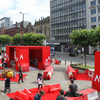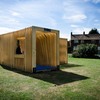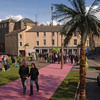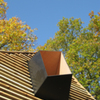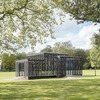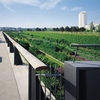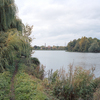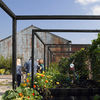Times Eureka Pavilion
Subscribe now to instantly view this image
Subscribe to the Architects’ Journal (AJ) for instant access to the AJ Buildings Library, an online database of nearly 2,000 exemplar buildings in photographs, plans, elevations and details.
Already a subscriber? Sign in
Front view at Kew
Marcus Peel (website) Download Original
Public garden and pavilion designed to communicate the significance of plants to science and society
Part of a small garden whose theme is ‘human dependency on plants’, this temporary pavilion is the latest in a string of quality architectural commissions by the Royal Botanic Gardens at Kew. Using principles of biomimicry, the architect NEX and landscape designer Marcus Barnett proposed a translucent pavilion based on the cellular structure of plants.
he design was developed using algorithms which replicate leaf capillaries.
Sitting on a raft of sustainably sourced spruce beams, primary timber ‘capillaries’ form the structure which is infilled with 136 unique timber cassettes and 586 unique plastic ‘cells’ made of recycled translucent polypropylene.
Rainwater from the roof runs through the capillaries inside the walls to the ground. The geometry of all the cassettes and cells radiates from two central vanishing points to create a dramatic and changing visual experience of the garden as visitors move through the structure. The pavilion can be dismantled and is entirely recyclable.
Data
- Begun: May 2011
- Completed: Jun 2011
- Floor area: 26m2
- Sectors: Public realm, Civic, Landscape design
- Total cost: £70,000
- Tender date: Jan 2011
- Address: Royal Botanic Gardens at Kew, Richmond, Surrey, TW9 3AB, United Kingdom
Professional Team 
- Architect: NEX
- Project architects: Alan Dempsey, James Chung, Michal Piasecki, Paul Loh, Tomas Starczewski
- Client: Royal Botanic Gardens Kew, The Times Newspaper
- Landscape design : Marcus Barnett
- Structural engineer: Buro Happold
Suppliers
- Main contractor: Outdoor Room
- Timber Fabrication: Blumer Lehmann






















